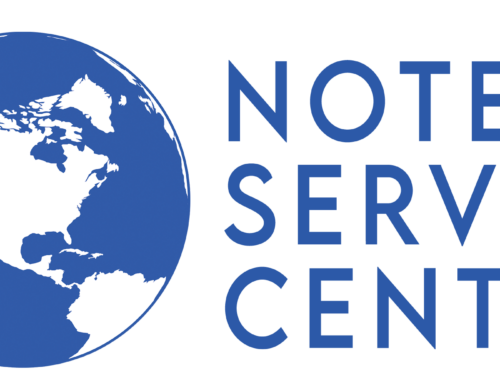Contents:
- Greeting from Roberta Standen
- How to Close Every Deal, Even in a Slow Market by David P. Butler
- Great News
- Upcoming Events(Seminars, Workshops)
Greetings to All our Friends and Colleagues
This year the Note Servicing Center is celebrating Twenty Five consecutive years in business. “Coming Soon”, the company will “roll out” a new dimension provided by a brand new division which will provide bill paying service for those in the Real Estate Community specializing in the use of the Subject To (Sub2) and Lease-Option methodology of choice. The need for a third party authority to collect from the borrower/Leasee/Optionee and distribute to the appropriate designee has oft been a stumbling block to a successful transaction. Information, details, material and forms should be available prior to March 1, 2009. Look for an e-mail announcement or contact us to get on the list to receive advanced information.
Pam is working hard to put together a series of Webinars on Seller Financing, Land Trusts, Lease Options and other methods to help you make this year one of the most profitable in the history of your business. The Webinars will be FREE and include some of best presenters in the business (including our own Tom Standen, a powerful authority and specialist in Notes and Trust Deeds) You won’t want to miss one of them. Watch for e-mail announcement.
How Will You Emerge from the Current Economic Environment?
Believe it or Not, You can come out stronger than ever!
The loan and real estate industry has been a roller coaster of highs and lows for those of us in the real estate, mortgage and loan business over the last year. We have faced many challenges not seen for several decades including some not seen by the current generation. While many are tempted to focus on the “doom and gloom,” I am confident in the ability of the industry to rise to occasion and tackle these challenges with vigor, enthusiasm and ingenuity recognizing that today’s challenges also present a number of opportunities for you.
If you have been in the real estate or mortgage industry for a few years, you may recall when interest rates exceeded 20%. I do – every escrow in our brokerage sales file fell apart. The good news is: We learned how to structure seller carry back financing and other private financing. To quote Les Brown who said of those times, “We were hungry”. Well, now we recognize the basis for these turbulent times is not rooted in high interest rates, but rather in the sub-prime debacle, shrinking equities and credit crunch, we know for sure that it’s downright tough to put together a sale that will stick and/or an escrow that will actually close. As Eddie Speed recently wrote, “If there’s ever been a year to learn about seller financing, 2009 is it! www.noteschool.com.
Let me add that “If there ever has been a year when Seller Financing will be the transaction “method of choice”, 2009 will be the year. We at the Note Servicing Center are able to “come along side you” in terms of your servicing needs regardless of the creativity or complexity in the structuring of seller carry back financing and private financing needs.
How to Close Every Deal, Even in a Slow Market
by David P. Butler
For real estate agents, business brokers, and mobile home dealers and brokers, seller-carryback financing can make the difference between a “sold” or an “expired” listing. This is particularly so in certain economic cycles, like the one we are entering NOW! A majority of listings expire, UNSOLD, especially single family residential (SFR) properties.
True…for the past ten years, open-market financing and the rise of the subprime lending industry made it unnecessary to use seller-financing as much as had been done over the previous sixty years–at least in the SFR marketplace.
But, as the housing market has drastically slowed over the past year (even in the face of relatively stable, lower interest rates) those sellers and their agents, who understand seller-carryback financing will make more sales!
The solution: Seller-financing closes the deal
Seller-carryback financing has continued to be used for all types of real estate, including mobile homes on lots or land; small or large apartment buildings, office buildings, commercial, industrial, motels, warehouse properties; special purpose properties such as theaters, hospitals, senior care facilities; and raw land, farms, or ranches.
It is heavily used to accomplish a number of other significant property transactions, including the sale of businesses (Approximately 90% of small businesses sold are seller-financed.) and the sale of mobile homes located in mobile home parks.
For real estate investors in particular, seller-financing has continued to be a primary tool in achieving their investment objectives. This is true whether they are buying or selling their investment properties. There are very compelling reasons for that.
My Favorite Uncle–Uncle Sam
Many sellers mistakenly think they need to pull all of the equity out of the sale of their property. Uncle Sam doesn’t seem to think that’s such a good idea, especially for real estate investors. Otherwise, he wouldn’t pound us so hard with those tax hits when we sell for cash out or reward us for structuring our real estate sales in certain other ways.
The U.S. Tax Code provides several strong incentives that make it exceptionally profitable for real estate investors to “both a lender and a borrower be!” The most recognized may be the Section 1031 tax-deferred exchange, which is the bailiwick of perhaps the most educated and creative people in real estate–professional Exchangors.
Section 453 (Installment Sales) allows investors to avoid the bulk of capital gains taxes ordinarily due on the sale their investment property. Using the seller-carryback installment payment technique, sellers can avoid what we call “tax friction” and defer these taxes, paying them in very small increments over a long period of time. As a result, sellers are able to reinvest their profits for even more profits.
Another meaty bone Uncle Sam throws investors is by way of Tax Code Section 163, which allows investors to write off interest on debt used to finance investment asset! Financing a high percentage of the purchase price generates a large interest deduction in the early years of ownership.
This deduction provides a tax shelter that can shield positive cash flow, as well as the equity buildup occurring through principal reduction on the loan, from taxation. At times, it may even shelter some of our other income from taxation as well.
The Icing on the Cake
Seller financing, if structured properly, creates an opportunity to maximize the sale value of the property. And the carryback note gives investors a well-secured, high-yielding, near-cash asset that offers greater flexibility in building up their investment portfolios.
These notes allow us to add strength to our financial statements while earning much better returns than cash accounts, making them valuable tools for further acquisitions and pyramiding the growth of a tax-sheltered wealth accumulation base.
Depending on their objectives, sellers have multiple options other than cash to achieve maximum advantage for profit structuring while cinching the sale of their property and building an healthy investment portfolio.
About the author…
David has a diverse background in investment analysis and contract negotiations in real estate purchases, leasing, exchange, and development; loan origination; private note transactions; and appraisal experience, including complex appraisal assignments and expert testimony for legal counsel in private court cases, as well as claims involving Bureau of Indian Affairs, IRS, and HUD.
David is the author of several highly regarded books in the private cash flow industry, including Tin Can Alley (Complete Guide To Making Money With Mobile Home Notes); Goin’ Downtown (Complete Guide To Making Money With Business Notes); Building Your War Chest (How To Acquire Working Capital For Note Investing); and Growing Your Food Chain (Hard Target Marketing For Note Brokers). He is a moderator for the Cash Flow Forum at Creative Real Estate Online, and is a regular presenter for the annual NoteWorthy Convention .
(“Reprinted and used with Permission of the Author – 1-2009”)
Great News – Cash Flow Exclusive E-Zine
Realizing that there has been a lack for the past several months of information that cash flow consultants need to further their businesses, a group of people who believe it is important to continually share vital information with the cash flow community has decided to find a way to provide it. To that end, they will begin publishing this month a new e-zine entitled Cash Flow Exclusive. It is exactly what its title implies – a publication exclusively for the cash flow industry. It will share with its readers the kinds of tips and information that should help cash flow consultants and brokers expand their horizons – very much the way the American Cash Flow Journal used to do. In short order, it will become part of a comprehensive Web site that will give cash flow professionals a resource for all kinds of services they need to enhance their efforts to bring alternative financing to small businesspeople and investors.
Both the publication and the Web site will be totally independent of the American Cash Flow Association. Its leaders are people who are dedicated to sharing the knowledge of experienced cash flow professionals with those who want to learn more. And we want to reconnect funding sources with the consultants who can bring them the business they are looking for.
Companies and investors radically affected by the current recession are just the kinds of people who can benefit from what cash flow professionals can provide. This e-zine and Web site will help you learn how to reach the people most in need – and how to meet their needs.
If you are interested in receiving a copy of Cash Flow Exclusive via e-mail, send your name and e-mail address to request@cashflowexclusive.com, and your name will be added to the list.
|






